Project Design & Implementation: Leadership, Skills & Outcomes
VerifiedAdded on 2023/06/14
|21
|3726
|361
Report
AI Summary
This report details the management of an innovative project, focusing on the application of transactional leadership and simulation techniques. It outlines the phases of the project, from preparation to implementation and outcome analysis, emphasizing the role of the project manager and team members. The report identifies skills developed, such as interpersonal communication, leadership, and strategic awareness, and evaluates actions taken and not taken during the project. Key learning outcomes include project selection, self-awareness, self-improvement, and the effective use of simulations in project management. The report concludes by highlighting the importance of leadership skills and rewarding team members for successful project completion, referencing various project management theories and models to support the analysis.
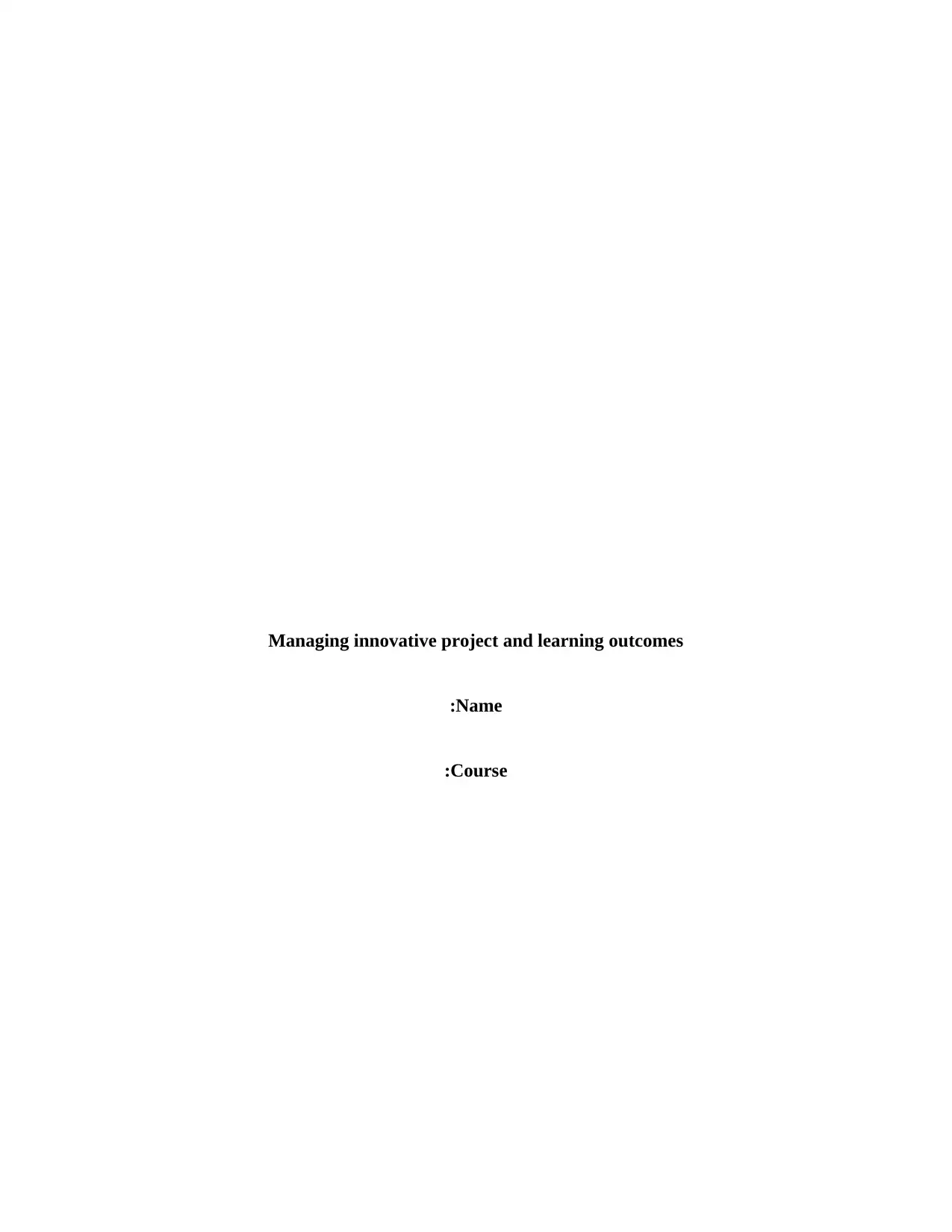
Managing innovative project and learning outcomes
Name:
Course:
Name:
Course:
Paraphrase This Document
Need a fresh take? Get an instant paraphrase of this document with our AI Paraphraser
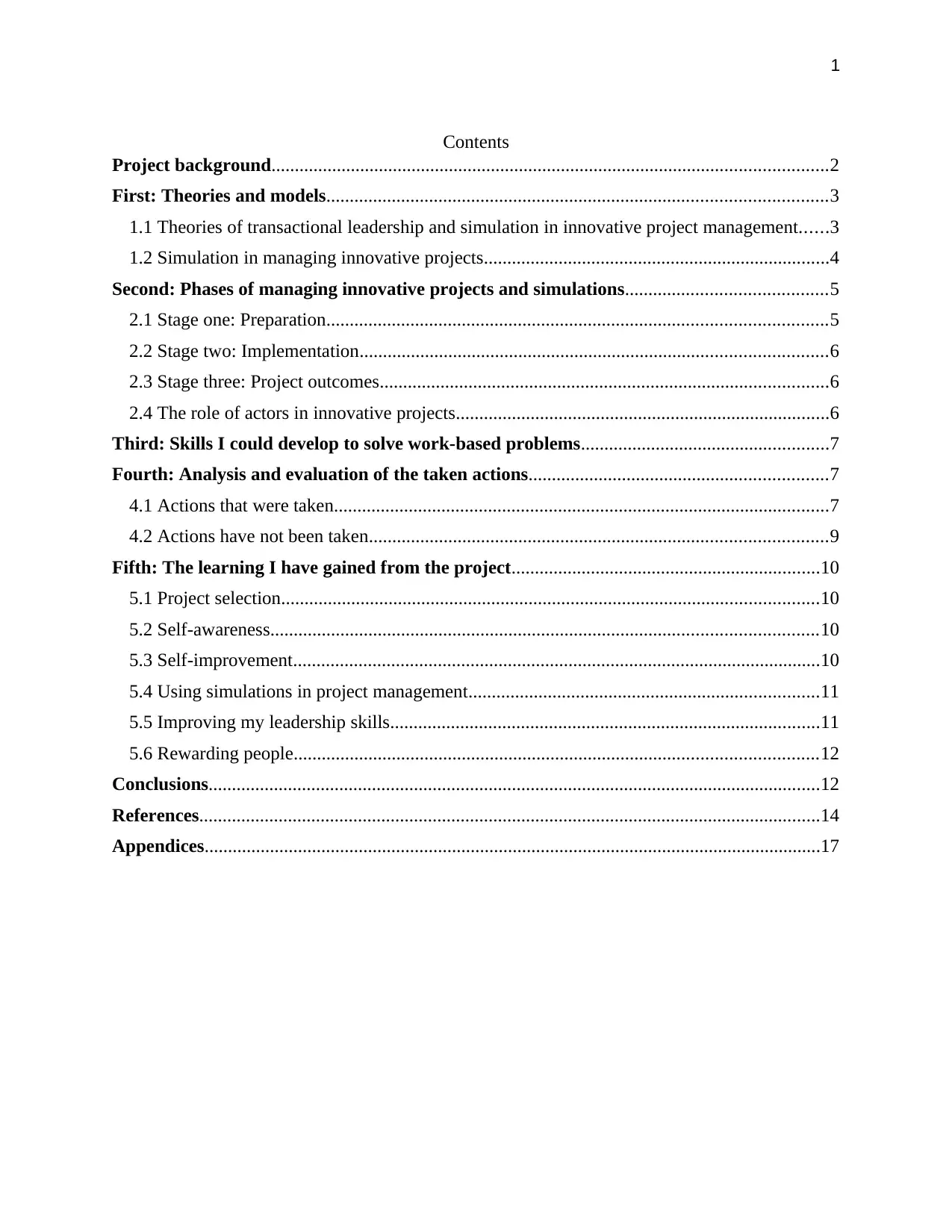
1
Contents
Project background.......................................................................................................................2
First: Theories and models...........................................................................................................3
1.1 Theories of transactional leadership and simulation in innovative project management......3
1.2 Simulation in managing innovative projects..........................................................................4
Second: Phases of managing innovative projects and simulations...........................................5
2.1 Stage one: Preparation...........................................................................................................5
2.2 Stage two: Implementation....................................................................................................6
2.3 Stage three: Project outcomes................................................................................................6
2.4 The role of actors in innovative projects................................................................................6
Third: Skills I could develop to solve work-based problems.....................................................7
Fourth: Analysis and evaluation of the taken actions................................................................7
4.1 Actions that were taken..........................................................................................................7
4.2 Actions have not been taken..................................................................................................9
Fifth: The learning I have gained from the project..................................................................10
5.1 Project selection...................................................................................................................10
5.2 Self-awareness.....................................................................................................................10
5.3 Self-improvement.................................................................................................................10
5.4 Using simulations in project management...........................................................................11
5.5 Improving my leadership skills............................................................................................11
5.6 Rewarding people................................................................................................................12
Conclusions...................................................................................................................................12
References.....................................................................................................................................14
Appendices....................................................................................................................................17
Contents
Project background.......................................................................................................................2
First: Theories and models...........................................................................................................3
1.1 Theories of transactional leadership and simulation in innovative project management......3
1.2 Simulation in managing innovative projects..........................................................................4
Second: Phases of managing innovative projects and simulations...........................................5
2.1 Stage one: Preparation...........................................................................................................5
2.2 Stage two: Implementation....................................................................................................6
2.3 Stage three: Project outcomes................................................................................................6
2.4 The role of actors in innovative projects................................................................................6
Third: Skills I could develop to solve work-based problems.....................................................7
Fourth: Analysis and evaluation of the taken actions................................................................7
4.1 Actions that were taken..........................................................................................................7
4.2 Actions have not been taken..................................................................................................9
Fifth: The learning I have gained from the project..................................................................10
5.1 Project selection...................................................................................................................10
5.2 Self-awareness.....................................................................................................................10
5.3 Self-improvement.................................................................................................................10
5.4 Using simulations in project management...........................................................................11
5.5 Improving my leadership skills............................................................................................11
5.6 Rewarding people................................................................................................................12
Conclusions...................................................................................................................................12
References.....................................................................................................................................14
Appendices....................................................................................................................................17
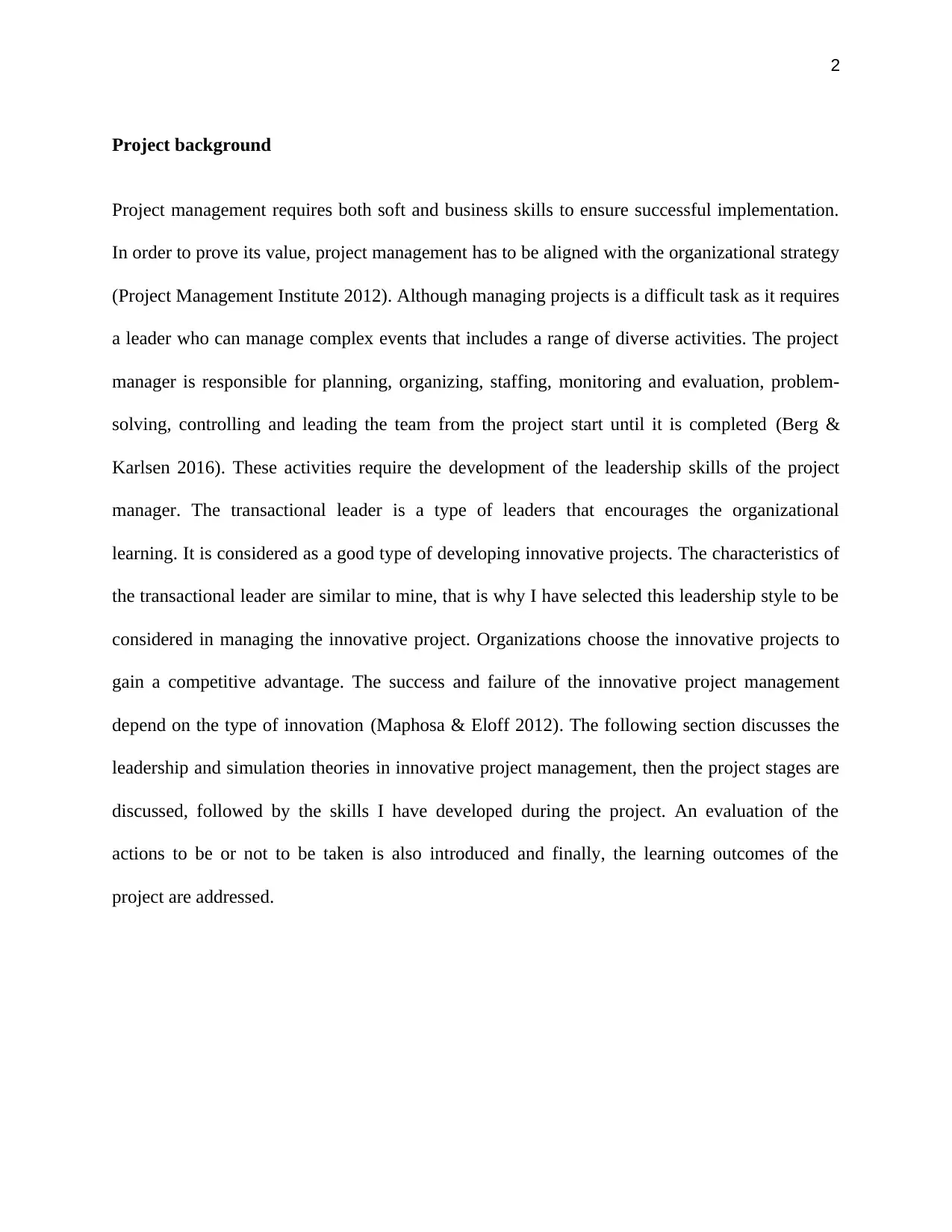
2
Project background
Project management requires both soft and business skills to ensure successful implementation.
In order to prove its value, project management has to be aligned with the organizational strategy
(Project Management Institute 2012). Although managing projects is a difficult task as it requires
a leader who can manage complex events that includes a range of diverse activities. The project
manager is responsible for planning, organizing, staffing, monitoring and evaluation, problem-
solving, controlling and leading the team from the project start until it is completed (Berg &
Karlsen 2016). These activities require the development of the leadership skills of the project
manager. The transactional leader is a type of leaders that encourages the organizational
learning. It is considered as a good type of developing innovative projects. The characteristics of
the transactional leader are similar to mine, that is why I have selected this leadership style to be
considered in managing the innovative project. Organizations choose the innovative projects to
gain a competitive advantage. The success and failure of the innovative project management
depend on the type of innovation (Maphosa & Eloff 2012). The following section discusses the
leadership and simulation theories in innovative project management, then the project stages are
discussed, followed by the skills I have developed during the project. An evaluation of the
actions to be or not to be taken is also introduced and finally, the learning outcomes of the
project are addressed.
Project background
Project management requires both soft and business skills to ensure successful implementation.
In order to prove its value, project management has to be aligned with the organizational strategy
(Project Management Institute 2012). Although managing projects is a difficult task as it requires
a leader who can manage complex events that includes a range of diverse activities. The project
manager is responsible for planning, organizing, staffing, monitoring and evaluation, problem-
solving, controlling and leading the team from the project start until it is completed (Berg &
Karlsen 2016). These activities require the development of the leadership skills of the project
manager. The transactional leader is a type of leaders that encourages the organizational
learning. It is considered as a good type of developing innovative projects. The characteristics of
the transactional leader are similar to mine, that is why I have selected this leadership style to be
considered in managing the innovative project. Organizations choose the innovative projects to
gain a competitive advantage. The success and failure of the innovative project management
depend on the type of innovation (Maphosa & Eloff 2012). The following section discusses the
leadership and simulation theories in innovative project management, then the project stages are
discussed, followed by the skills I have developed during the project. An evaluation of the
actions to be or not to be taken is also introduced and finally, the learning outcomes of the
project are addressed.
⊘ This is a preview!⊘
Do you want full access?
Subscribe today to unlock all pages.

Trusted by 1+ million students worldwide
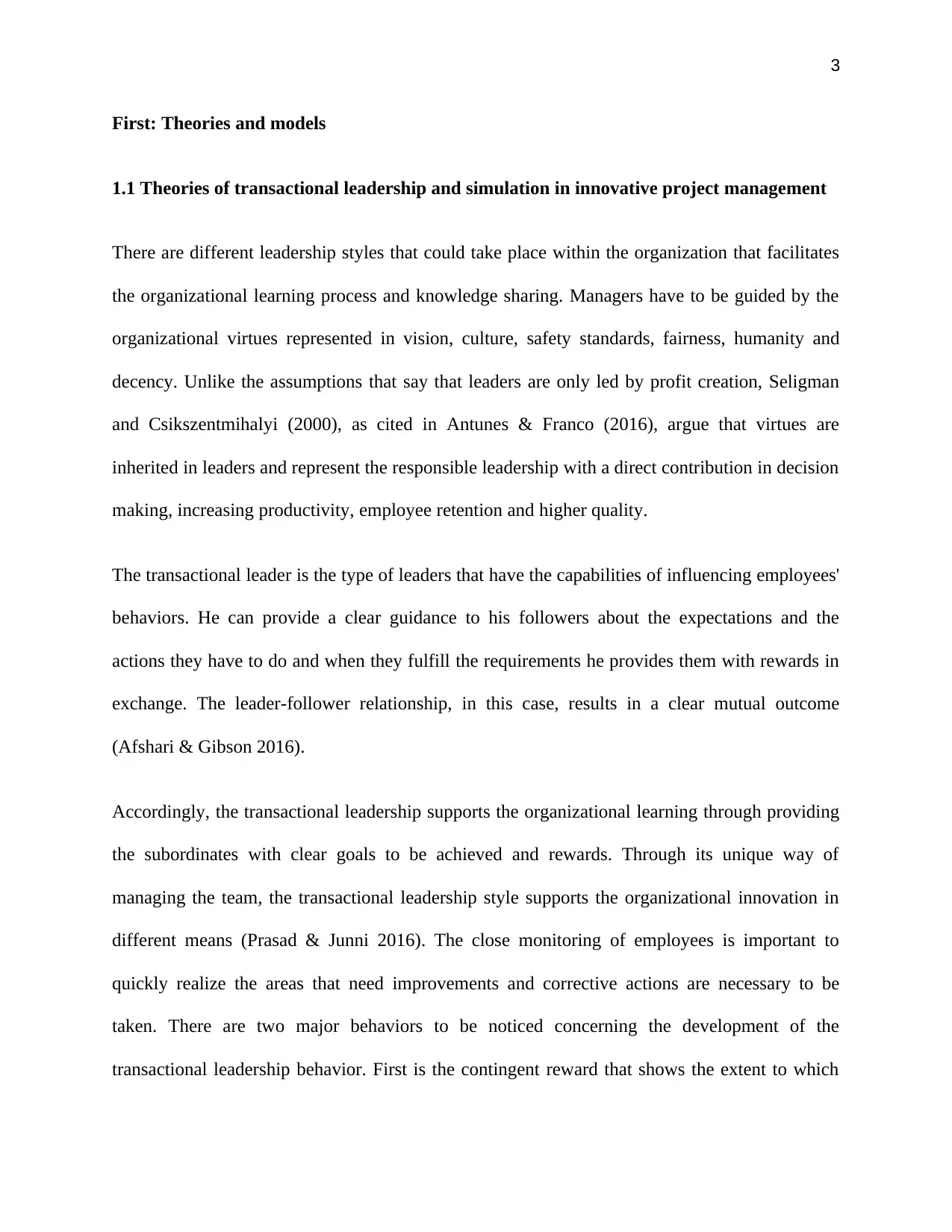
3
First: Theories and models
1.1 Theories of transactional leadership and simulation in innovative project management
There are different leadership styles that could take place within the organization that facilitates
the organizational learning process and knowledge sharing. Managers have to be guided by the
organizational virtues represented in vision, culture, safety standards, fairness, humanity and
decency. Unlike the assumptions that say that leaders are only led by profit creation, Seligman
and Csikszentmihalyi (2000), as cited in Antunes & Franco (2016), argue that virtues are
inherited in leaders and represent the responsible leadership with a direct contribution in decision
making, increasing productivity, employee retention and higher quality.
The transactional leader is the type of leaders that have the capabilities of influencing employees'
behaviors. He can provide a clear guidance to his followers about the expectations and the
actions they have to do and when they fulfill the requirements he provides them with rewards in
exchange. The leader-follower relationship, in this case, results in a clear mutual outcome
(Afshari & Gibson 2016).
Accordingly, the transactional leadership supports the organizational learning through providing
the subordinates with clear goals to be achieved and rewards. Through its unique way of
managing the team, the transactional leadership style supports the organizational innovation in
different means (Prasad & Junni 2016). The close monitoring of employees is important to
quickly realize the areas that need improvements and corrective actions are necessary to be
taken. There are two major behaviors to be noticed concerning the development of the
transactional leadership behavior. First is the contingent reward that shows the extent to which
First: Theories and models
1.1 Theories of transactional leadership and simulation in innovative project management
There are different leadership styles that could take place within the organization that facilitates
the organizational learning process and knowledge sharing. Managers have to be guided by the
organizational virtues represented in vision, culture, safety standards, fairness, humanity and
decency. Unlike the assumptions that say that leaders are only led by profit creation, Seligman
and Csikszentmihalyi (2000), as cited in Antunes & Franco (2016), argue that virtues are
inherited in leaders and represent the responsible leadership with a direct contribution in decision
making, increasing productivity, employee retention and higher quality.
The transactional leader is the type of leaders that have the capabilities of influencing employees'
behaviors. He can provide a clear guidance to his followers about the expectations and the
actions they have to do and when they fulfill the requirements he provides them with rewards in
exchange. The leader-follower relationship, in this case, results in a clear mutual outcome
(Afshari & Gibson 2016).
Accordingly, the transactional leadership supports the organizational learning through providing
the subordinates with clear goals to be achieved and rewards. Through its unique way of
managing the team, the transactional leadership style supports the organizational innovation in
different means (Prasad & Junni 2016). The close monitoring of employees is important to
quickly realize the areas that need improvements and corrective actions are necessary to be
taken. There are two major behaviors to be noticed concerning the development of the
transactional leadership behavior. First is the contingent reward that shows the extent to which
Paraphrase This Document
Need a fresh take? Get an instant paraphrase of this document with our AI Paraphraser
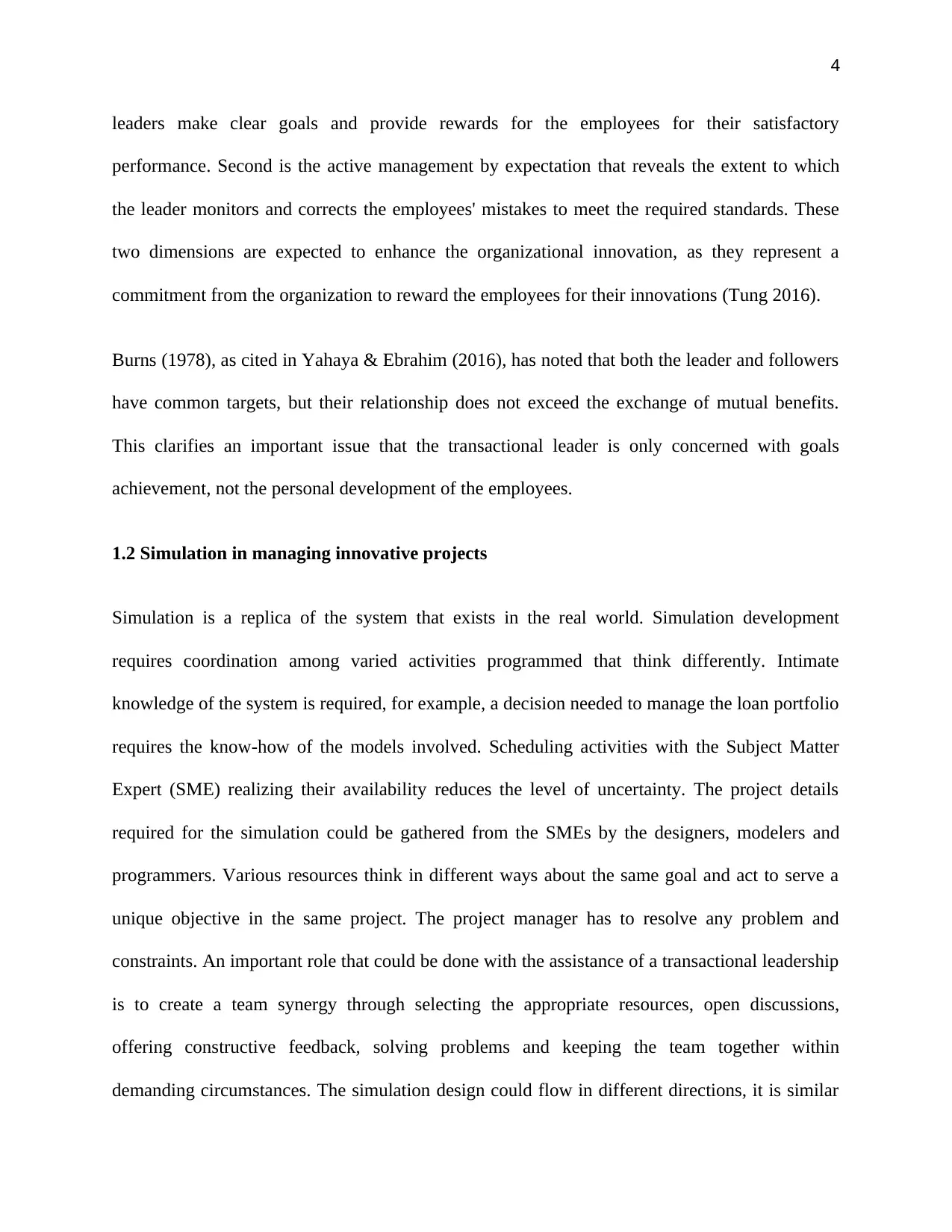
4
leaders make clear goals and provide rewards for the employees for their satisfactory
performance. Second is the active management by expectation that reveals the extent to which
the leader monitors and corrects the employees' mistakes to meet the required standards. These
two dimensions are expected to enhance the organizational innovation, as they represent a
commitment from the organization to reward the employees for their innovations (Tung 2016).
Burns (1978), as cited in Yahaya & Ebrahim (2016), has noted that both the leader and followers
have common targets, but their relationship does not exceed the exchange of mutual benefits.
This clarifies an important issue that the transactional leader is only concerned with goals
achievement, not the personal development of the employees.
1.2 Simulation in managing innovative projects
Simulation is a replica of the system that exists in the real world. Simulation development
requires coordination among varied activities programmed that think differently. Intimate
knowledge of the system is required, for example, a decision needed to manage the loan portfolio
requires the know-how of the models involved. Scheduling activities with the Subject Matter
Expert (SME) realizing their availability reduces the level of uncertainty. The project details
required for the simulation could be gathered from the SMEs by the designers, modelers and
programmers. Various resources think in different ways about the same goal and act to serve a
unique objective in the same project. The project manager has to resolve any problem and
constraints. An important role that could be done with the assistance of a transactional leadership
is to create a team synergy through selecting the appropriate resources, open discussions,
offering constructive feedback, solving problems and keeping the team together within
demanding circumstances. The simulation design could flow in different directions, it is similar
leaders make clear goals and provide rewards for the employees for their satisfactory
performance. Second is the active management by expectation that reveals the extent to which
the leader monitors and corrects the employees' mistakes to meet the required standards. These
two dimensions are expected to enhance the organizational innovation, as they represent a
commitment from the organization to reward the employees for their innovations (Tung 2016).
Burns (1978), as cited in Yahaya & Ebrahim (2016), has noted that both the leader and followers
have common targets, but their relationship does not exceed the exchange of mutual benefits.
This clarifies an important issue that the transactional leader is only concerned with goals
achievement, not the personal development of the employees.
1.2 Simulation in managing innovative projects
Simulation is a replica of the system that exists in the real world. Simulation development
requires coordination among varied activities programmed that think differently. Intimate
knowledge of the system is required, for example, a decision needed to manage the loan portfolio
requires the know-how of the models involved. Scheduling activities with the Subject Matter
Expert (SME) realizing their availability reduces the level of uncertainty. The project details
required for the simulation could be gathered from the SMEs by the designers, modelers and
programmers. Various resources think in different ways about the same goal and act to serve a
unique objective in the same project. The project manager has to resolve any problem and
constraints. An important role that could be done with the assistance of a transactional leadership
is to create a team synergy through selecting the appropriate resources, open discussions,
offering constructive feedback, solving problems and keeping the team together within
demanding circumstances. The simulation design could flow in different directions, it is similar
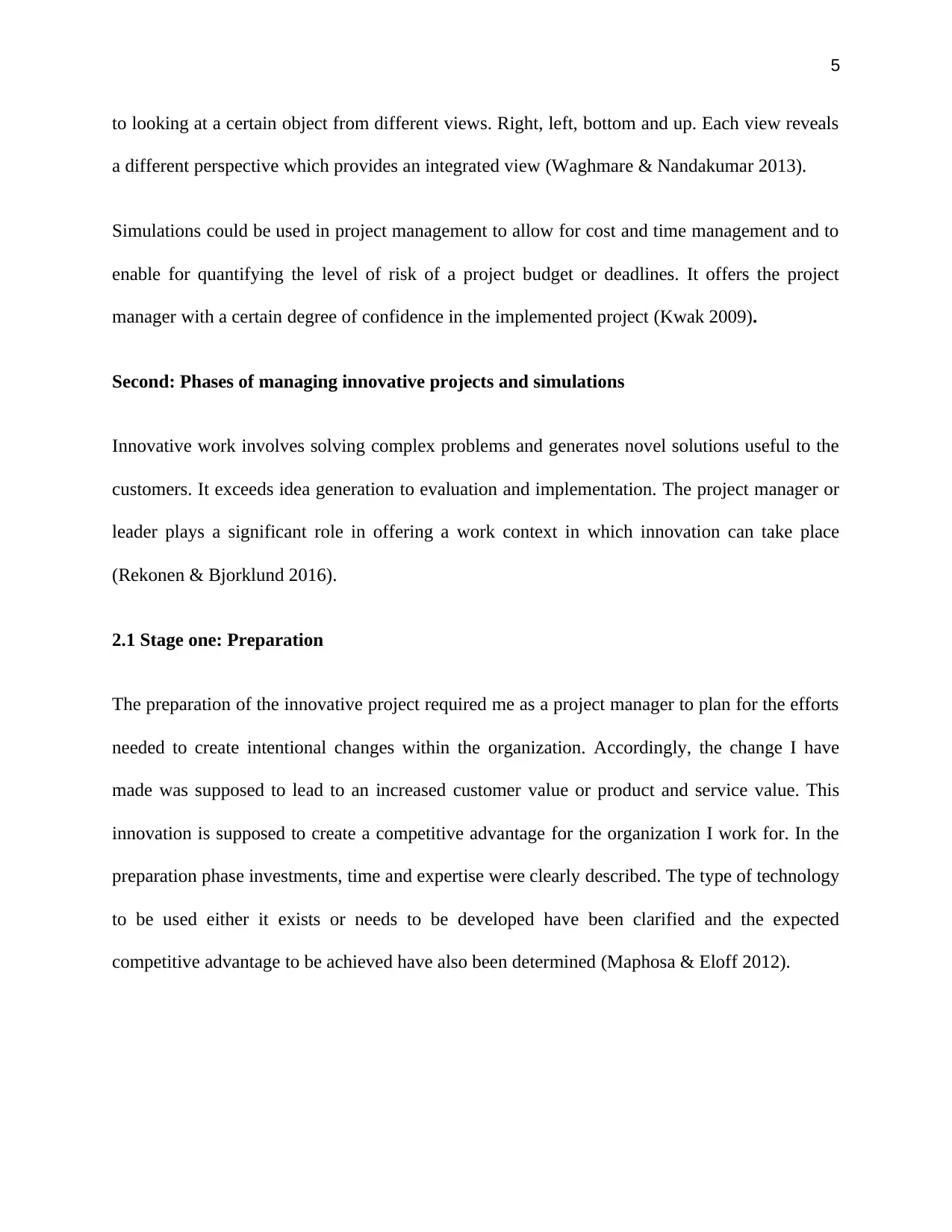
5
to looking at a certain object from different views. Right, left, bottom and up. Each view reveals
a different perspective which provides an integrated view (Waghmare & Nandakumar 2013).
Simulations could be used in project management to allow for cost and time management and to
enable for quantifying the level of risk of a project budget or deadlines. It offers the project
manager with a certain degree of confidence in the implemented project (Kwak 2009).
Second: Phases of managing innovative projects and simulations
Innovative work involves solving complex problems and generates novel solutions useful to the
customers. It exceeds idea generation to evaluation and implementation. The project manager or
leader plays a significant role in offering a work context in which innovation can take place
(Rekonen & Bjorklund 2016).
2.1 Stage one: Preparation
The preparation of the innovative project required me as a project manager to plan for the efforts
needed to create intentional changes within the organization. Accordingly, the change I have
made was supposed to lead to an increased customer value or product and service value. This
innovation is supposed to create a competitive advantage for the organization I work for. In the
preparation phase investments, time and expertise were clearly described. The type of technology
to be used either it exists or needs to be developed have been clarified and the expected
competitive advantage to be achieved have also been determined (Maphosa & Eloff 2012).
to looking at a certain object from different views. Right, left, bottom and up. Each view reveals
a different perspective which provides an integrated view (Waghmare & Nandakumar 2013).
Simulations could be used in project management to allow for cost and time management and to
enable for quantifying the level of risk of a project budget or deadlines. It offers the project
manager with a certain degree of confidence in the implemented project (Kwak 2009).
Second: Phases of managing innovative projects and simulations
Innovative work involves solving complex problems and generates novel solutions useful to the
customers. It exceeds idea generation to evaluation and implementation. The project manager or
leader plays a significant role in offering a work context in which innovation can take place
(Rekonen & Bjorklund 2016).
2.1 Stage one: Preparation
The preparation of the innovative project required me as a project manager to plan for the efforts
needed to create intentional changes within the organization. Accordingly, the change I have
made was supposed to lead to an increased customer value or product and service value. This
innovation is supposed to create a competitive advantage for the organization I work for. In the
preparation phase investments, time and expertise were clearly described. The type of technology
to be used either it exists or needs to be developed have been clarified and the expected
competitive advantage to be achieved have also been determined (Maphosa & Eloff 2012).
⊘ This is a preview!⊘
Do you want full access?
Subscribe today to unlock all pages.

Trusted by 1+ million students worldwide
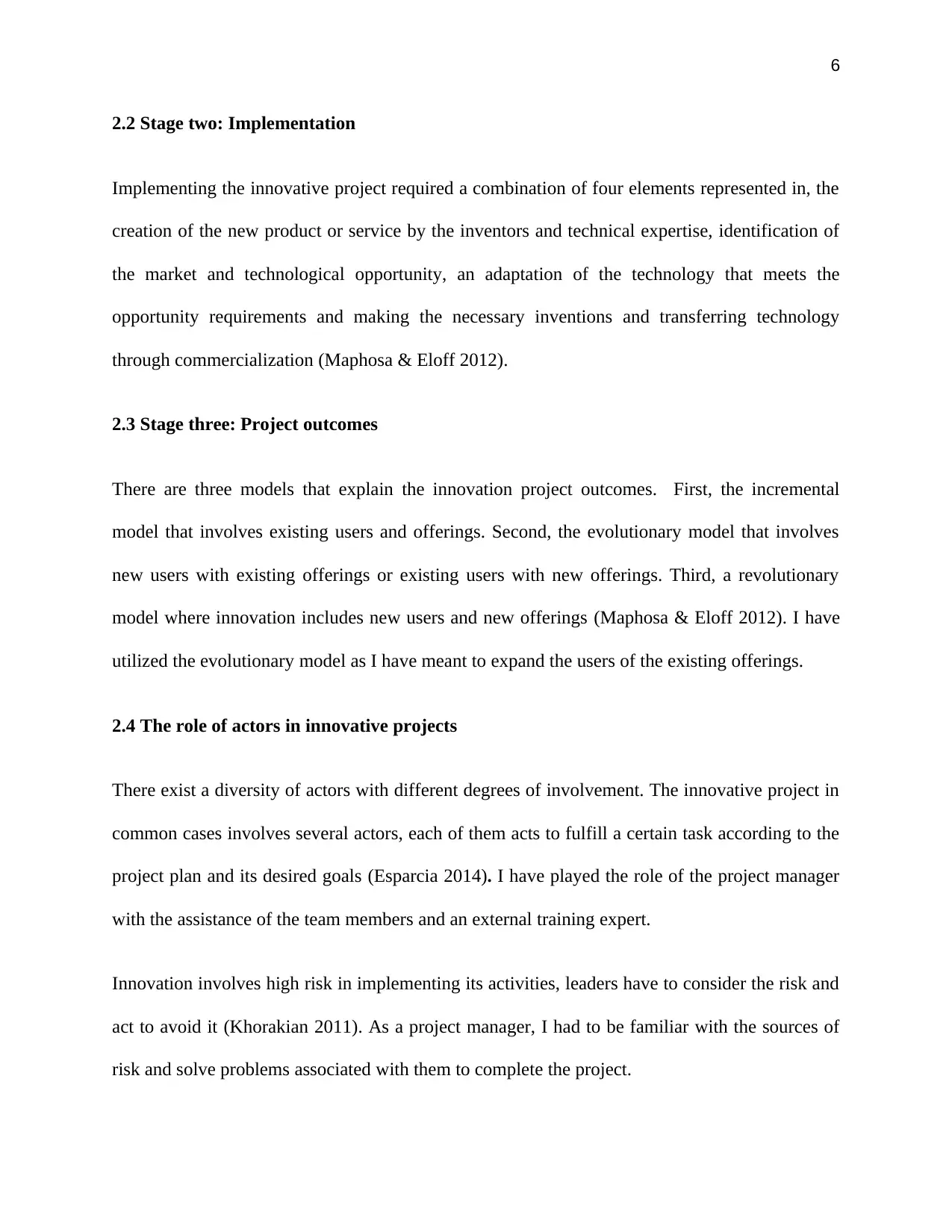
6
2.2 Stage two: Implementation
Implementing the innovative project required a combination of four elements represented in, the
creation of the new product or service by the inventors and technical expertise, identification of
the market and technological opportunity, an adaptation of the technology that meets the
opportunity requirements and making the necessary inventions and transferring technology
through commercialization (Maphosa & Eloff 2012).
2.3 Stage three: Project outcomes
There are three models that explain the innovation project outcomes. First, the incremental
model that involves existing users and offerings. Second, the evolutionary model that involves
new users with existing offerings or existing users with new offerings. Third, a revolutionary
model where innovation includes new users and new offerings (Maphosa & Eloff 2012). I have
utilized the evolutionary model as I have meant to expand the users of the existing offerings.
2.4 The role of actors in innovative projects
There exist a diversity of actors with different degrees of involvement. The innovative project in
common cases involves several actors, each of them acts to fulfill a certain task according to the
project plan and its desired goals (Esparcia 2014). I have played the role of the project manager
with the assistance of the team members and an external training expert.
Innovation involves high risk in implementing its activities, leaders have to consider the risk and
act to avoid it (Khorakian 2011). As a project manager, I had to be familiar with the sources of
risk and solve problems associated with them to complete the project.
2.2 Stage two: Implementation
Implementing the innovative project required a combination of four elements represented in, the
creation of the new product or service by the inventors and technical expertise, identification of
the market and technological opportunity, an adaptation of the technology that meets the
opportunity requirements and making the necessary inventions and transferring technology
through commercialization (Maphosa & Eloff 2012).
2.3 Stage three: Project outcomes
There are three models that explain the innovation project outcomes. First, the incremental
model that involves existing users and offerings. Second, the evolutionary model that involves
new users with existing offerings or existing users with new offerings. Third, a revolutionary
model where innovation includes new users and new offerings (Maphosa & Eloff 2012). I have
utilized the evolutionary model as I have meant to expand the users of the existing offerings.
2.4 The role of actors in innovative projects
There exist a diversity of actors with different degrees of involvement. The innovative project in
common cases involves several actors, each of them acts to fulfill a certain task according to the
project plan and its desired goals (Esparcia 2014). I have played the role of the project manager
with the assistance of the team members and an external training expert.
Innovation involves high risk in implementing its activities, leaders have to consider the risk and
act to avoid it (Khorakian 2011). As a project manager, I had to be familiar with the sources of
risk and solve problems associated with them to complete the project.
Paraphrase This Document
Need a fresh take? Get an instant paraphrase of this document with our AI Paraphraser
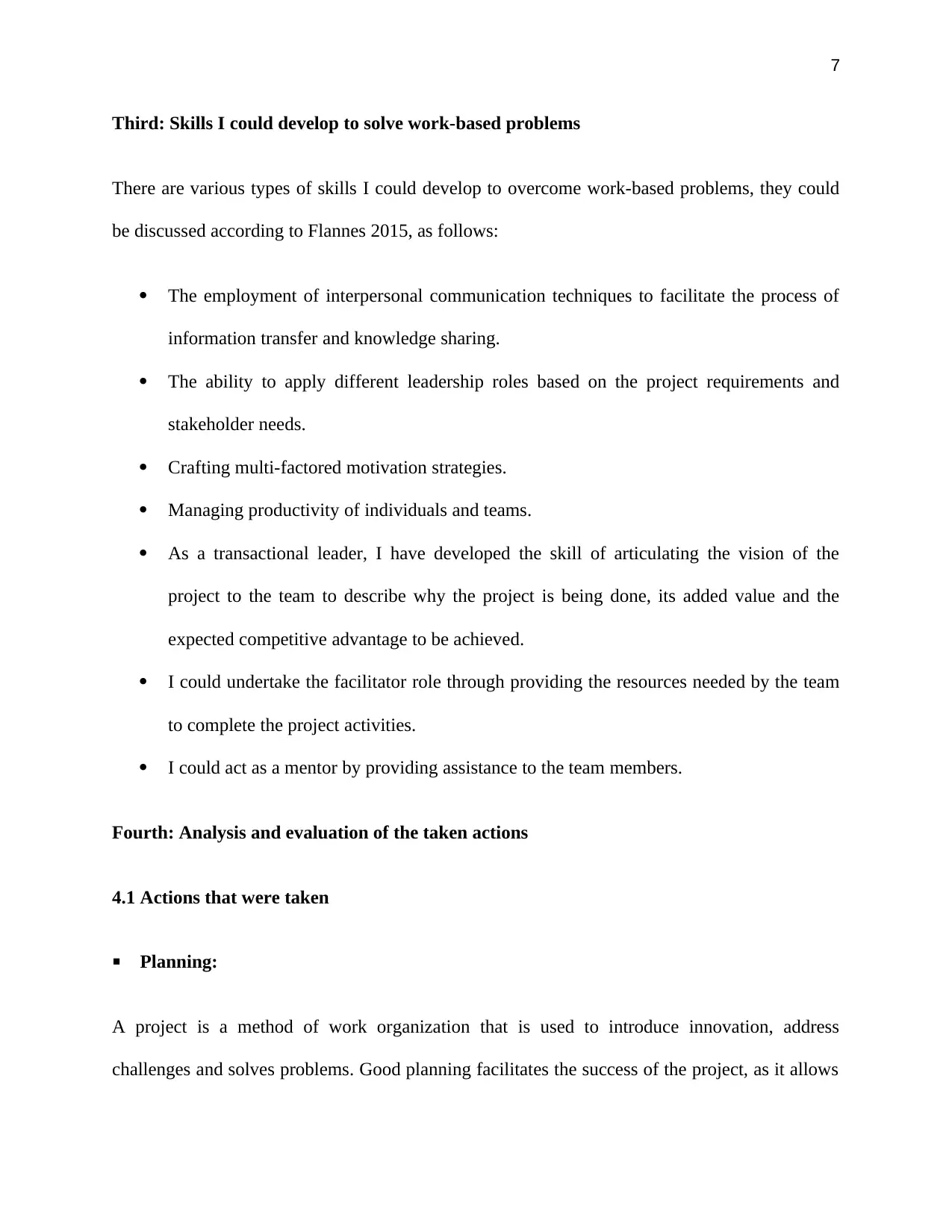
7
Third: Skills I could develop to solve work-based problems
There are various types of skills I could develop to overcome work-based problems, they could
be discussed according to Flannes 2015, as follows:
The employment of interpersonal communication techniques to facilitate the process of
information transfer and knowledge sharing.
The ability to apply different leadership roles based on the project requirements and
stakeholder needs.
Crafting multi-factored motivation strategies.
Managing productivity of individuals and teams.
As a transactional leader, I have developed the skill of articulating the vision of the
project to the team to describe why the project is being done, its added value and the
expected competitive advantage to be achieved.
I could undertake the facilitator role through providing the resources needed by the team
to complete the project activities.
I could act as a mentor by providing assistance to the team members.
Fourth: Analysis and evaluation of the taken actions
4.1 Actions that were taken
Planning:
A project is a method of work organization that is used to introduce innovation, address
challenges and solves problems. Good planning facilitates the success of the project, as it allows
Third: Skills I could develop to solve work-based problems
There are various types of skills I could develop to overcome work-based problems, they could
be discussed according to Flannes 2015, as follows:
The employment of interpersonal communication techniques to facilitate the process of
information transfer and knowledge sharing.
The ability to apply different leadership roles based on the project requirements and
stakeholder needs.
Crafting multi-factored motivation strategies.
Managing productivity of individuals and teams.
As a transactional leader, I have developed the skill of articulating the vision of the
project to the team to describe why the project is being done, its added value and the
expected competitive advantage to be achieved.
I could undertake the facilitator role through providing the resources needed by the team
to complete the project activities.
I could act as a mentor by providing assistance to the team members.
Fourth: Analysis and evaluation of the taken actions
4.1 Actions that were taken
Planning:
A project is a method of work organization that is used to introduce innovation, address
challenges and solves problems. Good planning facilitates the success of the project, as it allows
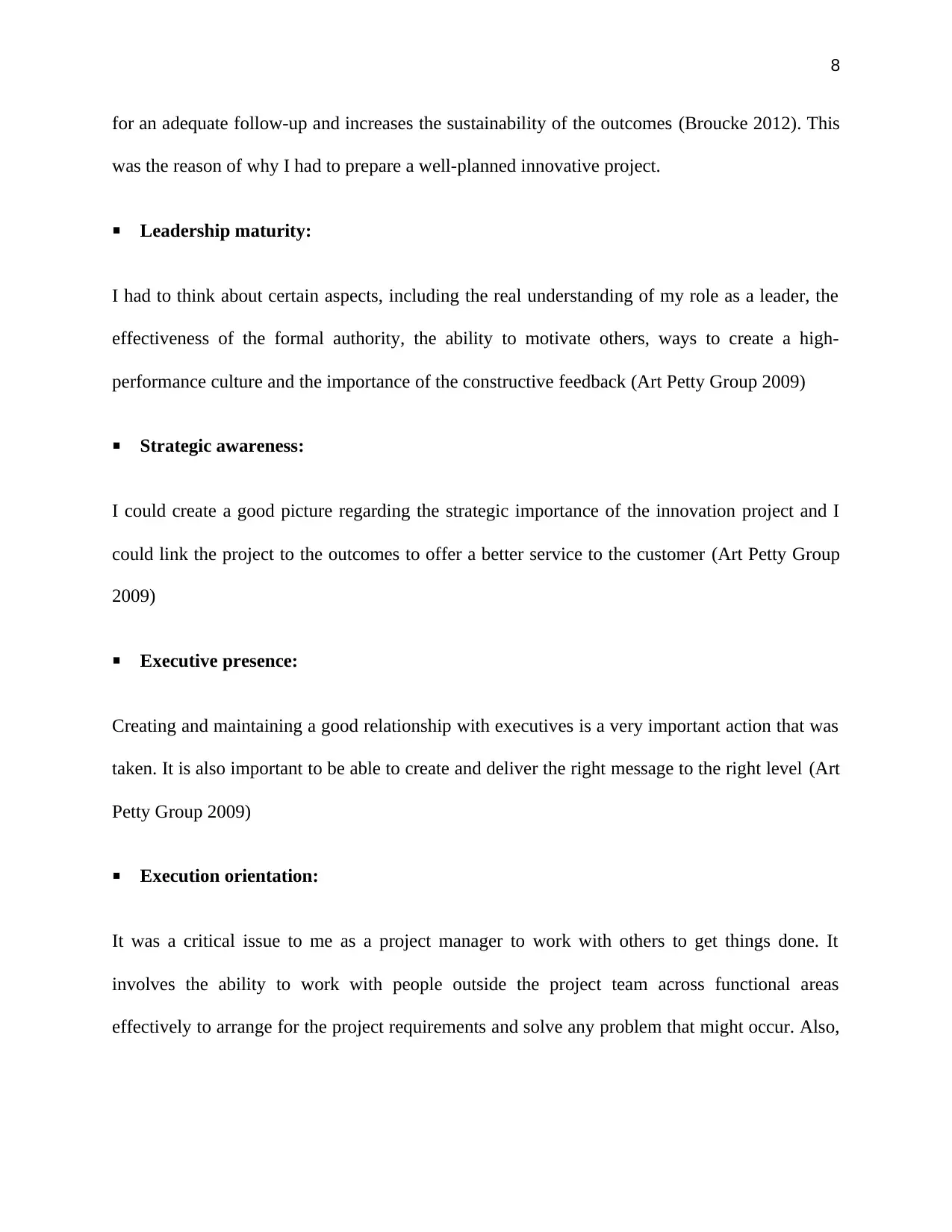
8
for an adequate follow-up and increases the sustainability of the outcomes (Broucke 2012). This
was the reason of why I had to prepare a well-planned innovative project.
Leadership maturity:
I had to think about certain aspects, including the real understanding of my role as a leader, the
effectiveness of the formal authority, the ability to motivate others, ways to create a high-
performance culture and the importance of the constructive feedback (Art Petty Group 2009)
Strategic awareness:
I could create a good picture regarding the strategic importance of the innovation project and I
could link the project to the outcomes to offer a better service to the customer (Art Petty Group
2009)
Executive presence:
Creating and maintaining a good relationship with executives is a very important action that was
taken. It is also important to be able to create and deliver the right message to the right level (Art
Petty Group 2009)
Execution orientation:
It was a critical issue to me as a project manager to work with others to get things done. It
involves the ability to work with people outside the project team across functional areas
effectively to arrange for the project requirements and solve any problem that might occur. Also,
for an adequate follow-up and increases the sustainability of the outcomes (Broucke 2012). This
was the reason of why I had to prepare a well-planned innovative project.
Leadership maturity:
I had to think about certain aspects, including the real understanding of my role as a leader, the
effectiveness of the formal authority, the ability to motivate others, ways to create a high-
performance culture and the importance of the constructive feedback (Art Petty Group 2009)
Strategic awareness:
I could create a good picture regarding the strategic importance of the innovation project and I
could link the project to the outcomes to offer a better service to the customer (Art Petty Group
2009)
Executive presence:
Creating and maintaining a good relationship with executives is a very important action that was
taken. It is also important to be able to create and deliver the right message to the right level (Art
Petty Group 2009)
Execution orientation:
It was a critical issue to me as a project manager to work with others to get things done. It
involves the ability to work with people outside the project team across functional areas
effectively to arrange for the project requirements and solve any problem that might occur. Also,
⊘ This is a preview!⊘
Do you want full access?
Subscribe today to unlock all pages.

Trusted by 1+ million students worldwide
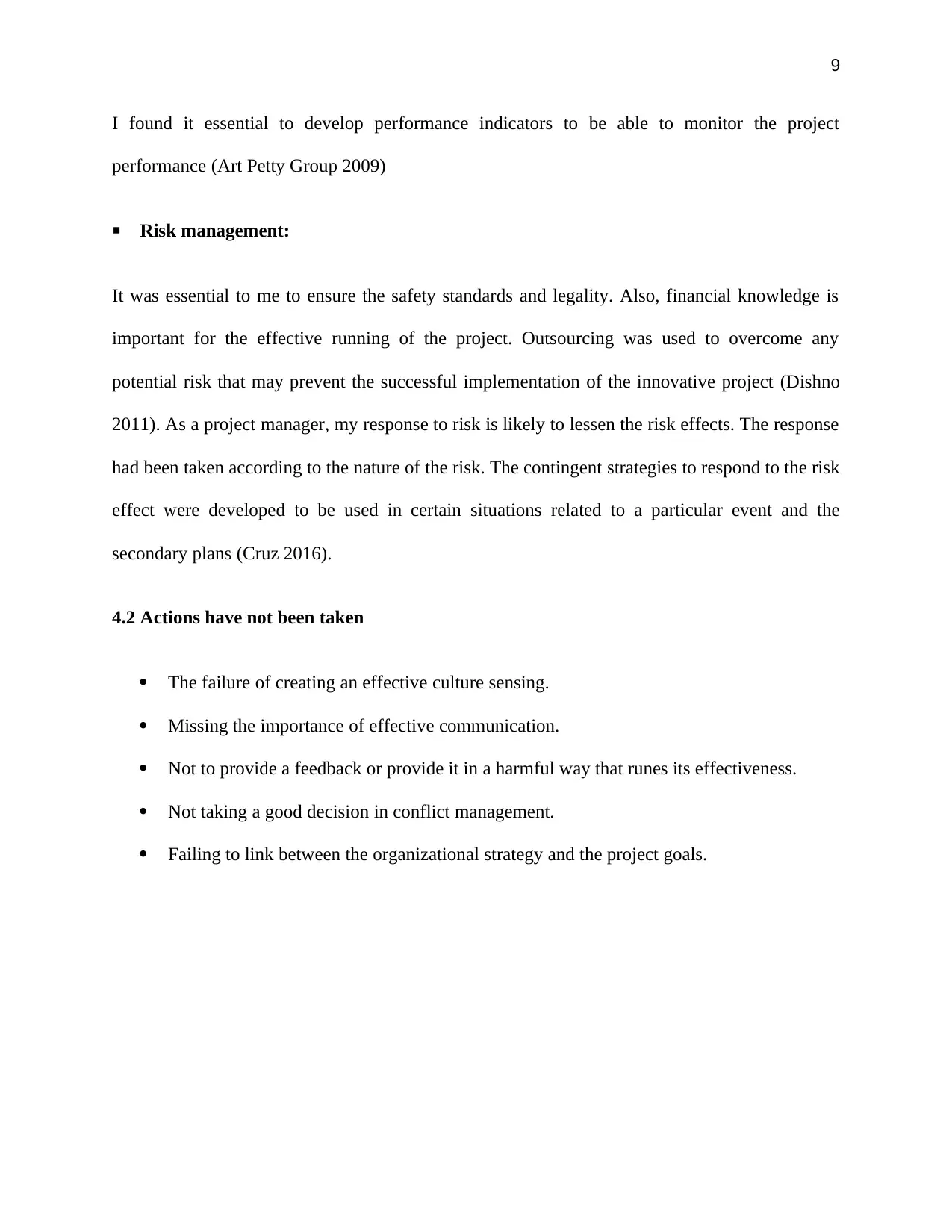
9
I found it essential to develop performance indicators to be able to monitor the project
performance (Art Petty Group 2009)
Risk management:
It was essential to me to ensure the safety standards and legality. Also, financial knowledge is
important for the effective running of the project. Outsourcing was used to overcome any
potential risk that may prevent the successful implementation of the innovative project (Dishno
2011). As a project manager, my response to risk is likely to lessen the risk effects. The response
had been taken according to the nature of the risk. The contingent strategies to respond to the risk
effect were developed to be used in certain situations related to a particular event and the
secondary plans (Cruz 2016).
4.2 Actions have not been taken
The failure of creating an effective culture sensing.
Missing the importance of effective communication.
Not to provide a feedback or provide it in a harmful way that runes its effectiveness.
Not taking a good decision in conflict management.
Failing to link between the organizational strategy and the project goals.
I found it essential to develop performance indicators to be able to monitor the project
performance (Art Petty Group 2009)
Risk management:
It was essential to me to ensure the safety standards and legality. Also, financial knowledge is
important for the effective running of the project. Outsourcing was used to overcome any
potential risk that may prevent the successful implementation of the innovative project (Dishno
2011). As a project manager, my response to risk is likely to lessen the risk effects. The response
had been taken according to the nature of the risk. The contingent strategies to respond to the risk
effect were developed to be used in certain situations related to a particular event and the
secondary plans (Cruz 2016).
4.2 Actions have not been taken
The failure of creating an effective culture sensing.
Missing the importance of effective communication.
Not to provide a feedback or provide it in a harmful way that runes its effectiveness.
Not taking a good decision in conflict management.
Failing to link between the organizational strategy and the project goals.
Paraphrase This Document
Need a fresh take? Get an instant paraphrase of this document with our AI Paraphraser
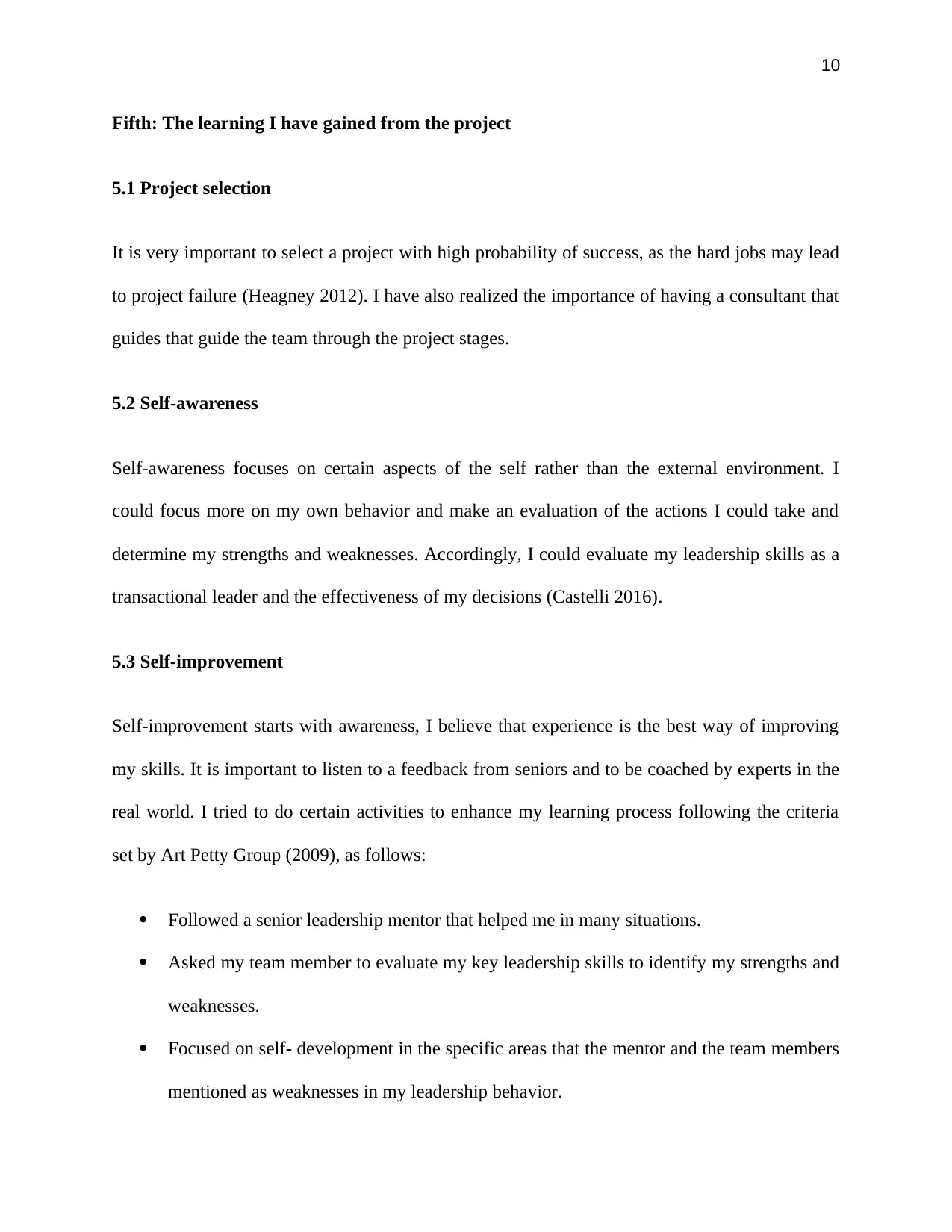
10
Fifth: The learning I have gained from the project
5.1 Project selection
It is very important to select a project with high probability of success, as the hard jobs may lead
to project failure (Heagney 2012). I have also realized the importance of having a consultant that
guides that guide the team through the project stages.
5.2 Self-awareness
Self-awareness focuses on certain aspects of the self rather than the external environment. I
could focus more on my own behavior and make an evaluation of the actions I could take and
determine my strengths and weaknesses. Accordingly, I could evaluate my leadership skills as a
transactional leader and the effectiveness of my decisions (Castelli 2016).
5.3 Self-improvement
Self-improvement starts with awareness, I believe that experience is the best way of improving
my skills. It is important to listen to a feedback from seniors and to be coached by experts in the
real world. I tried to do certain activities to enhance my learning process following the criteria
set by Art Petty Group (2009), as follows:
Followed a senior leadership mentor that helped me in many situations.
Asked my team member to evaluate my key leadership skills to identify my strengths and
weaknesses.
Focused on self- development in the specific areas that the mentor and the team members
mentioned as weaknesses in my leadership behavior.
Fifth: The learning I have gained from the project
5.1 Project selection
It is very important to select a project with high probability of success, as the hard jobs may lead
to project failure (Heagney 2012). I have also realized the importance of having a consultant that
guides that guide the team through the project stages.
5.2 Self-awareness
Self-awareness focuses on certain aspects of the self rather than the external environment. I
could focus more on my own behavior and make an evaluation of the actions I could take and
determine my strengths and weaknesses. Accordingly, I could evaluate my leadership skills as a
transactional leader and the effectiveness of my decisions (Castelli 2016).
5.3 Self-improvement
Self-improvement starts with awareness, I believe that experience is the best way of improving
my skills. It is important to listen to a feedback from seniors and to be coached by experts in the
real world. I tried to do certain activities to enhance my learning process following the criteria
set by Art Petty Group (2009), as follows:
Followed a senior leadership mentor that helped me in many situations.
Asked my team member to evaluate my key leadership skills to identify my strengths and
weaknesses.
Focused on self- development in the specific areas that the mentor and the team members
mentioned as weaknesses in my leadership behavior.
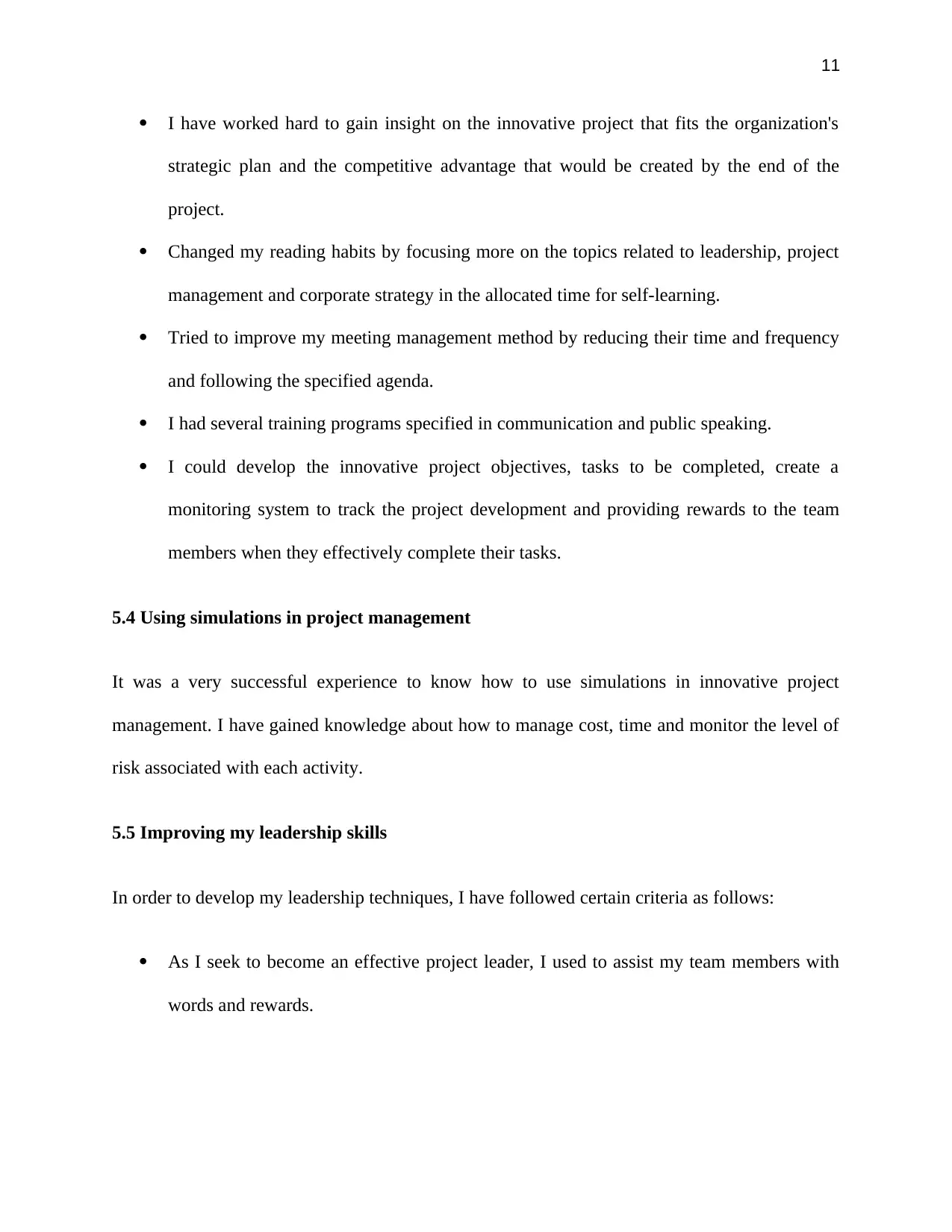
11
I have worked hard to gain insight on the innovative project that fits the organization's
strategic plan and the competitive advantage that would be created by the end of the
project.
Changed my reading habits by focusing more on the topics related to leadership, project
management and corporate strategy in the allocated time for self-learning.
Tried to improve my meeting management method by reducing their time and frequency
and following the specified agenda.
I had several training programs specified in communication and public speaking.
I could develop the innovative project objectives, tasks to be completed, create a
monitoring system to track the project development and providing rewards to the team
members when they effectively complete their tasks.
5.4 Using simulations in project management
It was a very successful experience to know how to use simulations in innovative project
management. I have gained knowledge about how to manage cost, time and monitor the level of
risk associated with each activity.
5.5 Improving my leadership skills
In order to develop my leadership techniques, I have followed certain criteria as follows:
As I seek to become an effective project leader, I used to assist my team members with
words and rewards.
I have worked hard to gain insight on the innovative project that fits the organization's
strategic plan and the competitive advantage that would be created by the end of the
project.
Changed my reading habits by focusing more on the topics related to leadership, project
management and corporate strategy in the allocated time for self-learning.
Tried to improve my meeting management method by reducing their time and frequency
and following the specified agenda.
I had several training programs specified in communication and public speaking.
I could develop the innovative project objectives, tasks to be completed, create a
monitoring system to track the project development and providing rewards to the team
members when they effectively complete their tasks.
5.4 Using simulations in project management
It was a very successful experience to know how to use simulations in innovative project
management. I have gained knowledge about how to manage cost, time and monitor the level of
risk associated with each activity.
5.5 Improving my leadership skills
In order to develop my leadership techniques, I have followed certain criteria as follows:
As I seek to become an effective project leader, I used to assist my team members with
words and rewards.
⊘ This is a preview!⊘
Do you want full access?
Subscribe today to unlock all pages.

Trusted by 1+ million students worldwide
1 out of 21
Related Documents
Your All-in-One AI-Powered Toolkit for Academic Success.
+13062052269
info@desklib.com
Available 24*7 on WhatsApp / Email
![[object Object]](/_next/static/media/star-bottom.7253800d.svg)
Unlock your academic potential
Copyright © 2020–2025 A2Z Services. All Rights Reserved. Developed and managed by ZUCOL.




